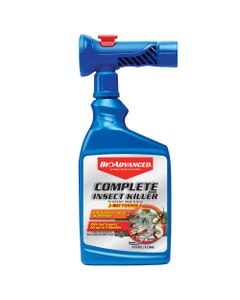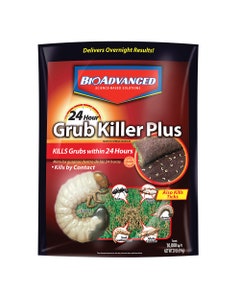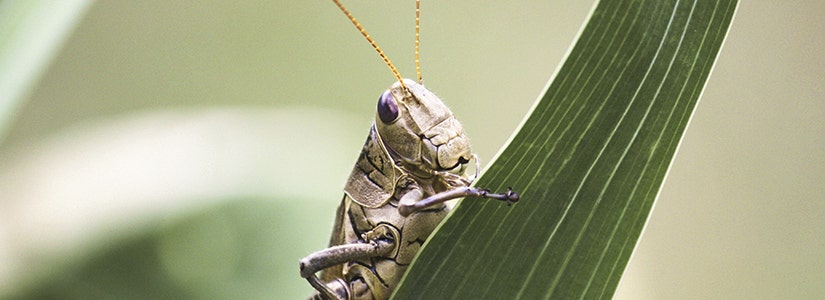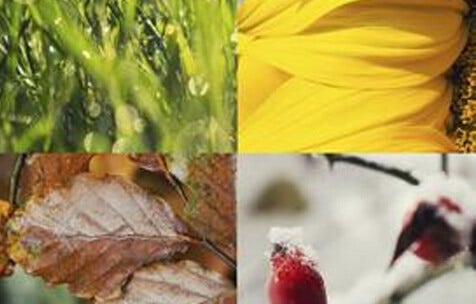

- Home
- Solution Center
- Learn
- Outdoor Pests
- Fall Lawn Destroying Insects: Invaders in Your Yard
Fall Lawn Destroying Insects: Invaders in Your Yard
Fall's arrival marks a time of relief for gardens. Plants usually need less frequent irrigation and many pests have completed the plant-destruction phase of their life cycles.Still, a few garden pests make their presence known in fall. Learn what symptoms to look for so you can address any pest problems.
Lawn Grubs
Brown spots in your lawn may signal that Grubs are present and feasting on grass roots. To determine if Grubs are the culprit, pull on the brown grass. If it pulls free with no roots, carefully dig and lift a section to check for c-shaped Grubs.
It's worth trying to control Grubs this fall, because in spring they'll continue their underground lawn destruction.
Other signs of Lawn Grubs:skunks, raccoons or armadillos burrowing into lawn; flocks of birds feeding in the lawn.
Target plants include:Grubs feed on turf roots; adult Beetles attack many garden plants earlier in summer; if you saw many Japanese or Chafer (June-type) Beetles in early summer, you may have Grubs.
Brown Marmorated Stink Bugs

In autumn, Stink Bugs begin their search for winter quarters and they often hope to spend the season inside your home's wall voids. If you had Stink Bugs last year, they left an invisible chemical alerting their smelly buddies of the way indoors.
If Stink Bugs start showing up in your home and garden, take action against them.It also helps to start sealing up insect pathways into your home.
Other signs of Stink Bugs:brown or circular yellow spots on fruit, such as apples or tomatoes.
Target plants include: soft fruits, many vegetables and ornamental plants.
Boxelder Bugs

This is another pest that starts seeking winter shelter in fall. This black insect with red marks on its wings is easily identified. If summer a year ago was hot and dry, and this past spring was warm, look out for a bumper crop of these slow-walking insects.
Read more about Boxelder Bugs, including why they gather by the hundreds and what you can do about it.
Other signs of Boxelder Bugs:masses of insects on exterior southern or western walls.
Target plants include: boxelder (especially female or seed-bearing trees), maple and ash trees.
Bagworms

These Caterpillars create small bags made from bits of twigs and leaves that measure up to 2.5 inches long. You'll see the bags dangling along evergreen branches, the underside of porch roofs and other surfaces in autumn.
In spring, eggs that wintered inside the bags hatch and Caterpillars emerge to start the feeding and breeding cycle anew. Bagworms don't typically cause immense damage to plants, but the bags are unsightly, especially when numbers are large. In a heavy infestation, trees can be defoliated, even conifers.
Other signs of Bagworms:ragged, chewed foliage on deciduous trees.
Target plants include:deciduous and evergreen trees and shrubs; heaviest damage usually occurs on arborvitae and junipers.
Slugs and Snails

Slugs and Snails lay up to 60% of their eggs in fall. In warmer regions, the arrival of fall rains marks the start of egg laying. Young hatchin 10-21 days, mature in as little as 40 days, and then overwinter to begin feeding in early spring.
If you're unsure whether you're battling Slugs and Snails, look for classic slime trails on surfaces. On mature plants, sections of leaves may be eaten between veins; young seedlings disappear overnight.
Other signs of Slugs and Snails:narrow trails of missing skin on ripening tomatoes, chunks of Pansy petals missing.
Target plants include:ornamental plants, seedlings, ripening fruits and vegetables.
Yellow Jackets

These stinging pests become intensely active in late summer and early fall. Adult insects sip nectar from flowers and feed on the juice of damaged fruit.
Yellow Jackets are beneficial insects preying on Caterpillars and soft-bodied insects, such as Aphids or immature Scale insects.If possible, avoid destroying nests unless they pose a real threat to your family.
Other signs of Yellow Jackets:nest may be open combs, large enclosed paper nests or small entrance holes to underground nests.
Target plants include:flowering garden plants, herbs (like Dill, Fennel) and fallen fruit.
Fall Webworms
These Caterpillars congregate at tree branch tips, spinning silken webs. The gray-haired, black-spotted caterpillars may be yellow-green with a black head or tan with a red head.
Worms feast inside webbing, increasing the nest size as they grow. It's unusual for worm feeding to defoliate a tree, but it can occur with a young or small tree. A greater impact of worm feeding is seen in trees like pecans, which frequently experience a smaller nut crop the year following a heavy fall infestation.
Other signs of fall webworm: Caterpillars gathering at branch tips; webbing surrounding branch tips.
Target plants include:nearly every tree except conifers; favorites include mulberry, elm, sweetgum, willow, oak, linden, apple and other fruit trees.
Photo Captions:Image 1327103: Alton N. Sparks, Jr., University of Georgia, Bugwood.orgImage 1460048: David R. Lance, USDA APHIS PPQ, Bugwood.orgImage 5436339: Chazz Hesselein, Alabama Cooperative Extension System, Bugwood.orgImage 1192005: Gary Bernon, USDA APHIS, Bugwood.orgImage 5141006: Johnny N. Dell, Bugwood.orgImage 1388026: Steven Katovich, USDA Forest Service, Bugwood.org














